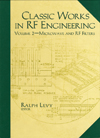History of Wireless
T.K. Sarkar, R.J. Mailloux, A.A. Oliner, M. Salazar-Palma and D.L. Sengupta, Eds.
674 pages; $59.95 • Wiley-Interscience
ISBN: 978-0-471-71814-7
 Traditionally used to transmit radio signals, wireless technology has experienced explosive growth in recent years and now comprises a large share of the telecommunications industry. Challenging traditional assumptions about the origins and growth of wireless, History of Wireless is a comprehensive treatment of the history and evolution of this vital technology.
Traditionally used to transmit radio signals, wireless technology has experienced explosive growth in recent years and now comprises a large share of the telecommunications industry. Challenging traditional assumptions about the origins and growth of wireless, History of Wireless is a comprehensive treatment of the history and evolution of this vital technology.
Introducing previously unacknowledged pioneers and developments, this book offers new insights into the initial theory and experimental exploration of wireless. It explores the development of magnetism, electricity and light, covering the widely recognized contributions of James Clerk Maxwell; Heinrich Hertz, who discovered electromagnetic waves in the late 19th century; and Guglielmo Marconi, who introduced the first wireless telegraph. The book also examines the work of Oliver Heaviside and Nikola Tesla, who both contributed significantly to the development of radio. Incorporating the approach that one cannot understand the science of wireless without knowing how various components and systems evolved, this book supplements conventionally accepted stories with more specific, less known discoveries and individuals.
The History of Wireless also covers German, Japanese and Soviet contributions to the physics and applications of electromagnetic oscillations and waves, wireless telegraphic and telephonic developments, and attempts to achieve transatlantic wireless communications, wireless telegraphy in South Africa in the early 20th century, antenna development in Japan, Soviet quasi-optics at near-mm and sub-mm wavelengths, the evolution of electromagnetic waveguides, and the development of phased-array antennas.
To order this book, contact:
John Wiley & Sons Inc.
Hoboken, NJ 08875
(800) CALL WILEY
Classic Works in RF Engineering: Volume 2—Microwave and RF Filters
Ralph Levy, Editor
418 pages; $129, £61 • Artech House
ISBN: 978-1-59693-212-8
 This book does a beautiful job of presenting the reader with a selection of 51 papers on RF and microwave filters that are most relevant to the requirements that exist today. Some early papers that were considered to be breakthroughs at the time they were published are not included if they have become superseded by later work. The reprints are grouped in ten categories, each one preceded by an introduction giving an overview of the particular class of filters in a given category. Chapter 1 is concerned with basic bandpass filters of the simple Chebyshev or Butterworth type, that is without finite frequency loss poles or transmission zeros. Modern filter design relies to a considerable extent on so-called transformed-variable synthesis, which is the subject of Chapter 2. This is similar to synthesis using the standard complex frequency variable, but with the addition of a frequency transformation.
This book does a beautiful job of presenting the reader with a selection of 51 papers on RF and microwave filters that are most relevant to the requirements that exist today. Some early papers that were considered to be breakthroughs at the time they were published are not included if they have become superseded by later work. The reprints are grouped in ten categories, each one preceded by an introduction giving an overview of the particular class of filters in a given category. Chapter 1 is concerned with basic bandpass filters of the simple Chebyshev or Butterworth type, that is without finite frequency loss poles or transmission zeros. Modern filter design relies to a considerable extent on so-called transformed-variable synthesis, which is the subject of Chapter 2. This is similar to synthesis using the standard complex frequency variable, but with the addition of a frequency transformation.
Chapter 3 is devoted to cross-coupled and pseudo-elliptic filters. Chapter 4 describes parallel-coupled line, hairpin-line and microstrip bandpass filters. Chapter 5 is concerned with dielectric-resonator filters, which are used for two purposes: to reduce the size of filter cavities and to increase the unloaded Q, resulting in much lower loss. Bandstop filters are the subject of Chapter 6, while Chapter 7 is consecrated to low pass filters. Suspended substrate stripline filters are described in Chapter 8. It is not always realized that lumped element filters may be built to operate at frequencies up to perhaps 18 GHz. Chapter 9 offers examples of this kind of filter. Chapter 10 comprises papers on power-handling, insertion loss, group delay and tuning. It is very interesting to read these classic works and learn from the best selection of papers in this field.
To order this book, contact:
Artech House
685 Canton St.
Norwood, MA 02062
(781) 769-9750 ext. 4030; or
46 Gillingham St.
London SW1V 1HH, UK
+44 (0) 207-8750
